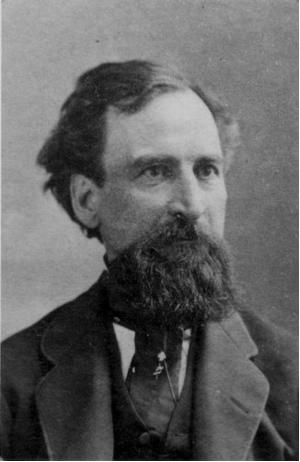Episode 32: Avery and the Log
This quarter plate daguerreotype by Platt Babbitt of Joseph Avery stuck in the rapids was sold by Sotheby’s on 27 April 1999. It is now in the collection of the Nelson Atkins Museum of Art (see a larger version of the image at the link). It is presumably a copy of the original plate. Keep in mind this is a mirror image of the scene as are most early daguerreotypes.
Other plates of this image can be located here:
-whole-plate in the Local History Collection of the Niagara Falls, New York, Public Library
-quarter-plate in The Library of Congress, Prints and Photographs Department
-sixth-plate in Science + Media Museum, Bradford, UK
This daguerreotype is in the collection of the Niagara Falls Public Library. On the reverse of the photograph, it is written:
This is a picture of Avery on the rock in the rapids above the American Fall. It was taken July 19, 1853, on a copper plate by P.D. Babbit [sic.], who was the photographer at Point View (now Prospect Point). All-day efforts to rescue Avery failed and he went over the falls that afternoon. The day of the tragedy, Judge Thoe. [sic.] G. Hulett [sic.] passed the hat among the crowd that gathered and collected $182.22 which he turned over to Augustus S. Porter, president of the village board of trustees.
(Niagara Falls Public Library, Niagara Falls, N.Y.)
Portrait of Platt Delascus Babbitt (1823-1879) by James Landy.
This is what John Werge had to say about Platt Babbitt in the book he wrote in 1890:
‘I next went to Niagara Falls, where it was my good fortune to encounter two very different specimens of American character in the persons of Mr. Easterly and Mr. Babbitt, the former a visitor and the latter a resident Daguerrean, who held a monopoly]from General Porter to Daguerreotype the Falls and visitors. He had a pavilion on the American side of the Falls, under which his camera was in position all day long, and when a group of visitors stood on the shore to survey the Falls from that point, he took the group—without their knowledge—and showed it to the visitors before they left. In almost every instance he sold the picture at a good price; the people were generally delighted to be taken at the Falls. I need hardly say that they were all taken instantaneously, and embraced a good general view, including the American Fall, Goat Island, the Horse Shoe Fall, and the Canadian shore. Many of these views I coloured for Mr. Babbitt, but there was always a beautiful green colour on the brink of the Horse Shoe Fall which I never could match. For many years I possessed one of Mr. Babbitt’s Daguerreotype views, as well as others taken by Mr. Easterly and myself, but I had the misfortune to be deprived of them all by fire. Some years after I lent them to an exhibition in Glasgow, which was burnt down, and all the exhibits destroyed. After a delightful sojourn of three weeks at Niagara Falls, I took steamer on the lower Niagara River, sailed down to Lake Ontario, and down the River St. Lawrence, shooting the Lachine Rapids, and on to Montreal.’
Platt Babbitt, Niagara Falls from Prospect Point, circa 1855, Collection of the National Gallery of Canada
Mark A. DiLaura’s article ‘Niagara Falls’ in StereoWorld offers fascinating information about Platt Babbitt and other photographers active in the area, as well as what life was like in the early years of the town:
..the Niagara season was at its height; the monster hotels were ringing with song, music and dance; tourists were doing the falls, and the touts were doing the tourists ... a comical pageant of itinerant philosophers and honeymooners behaving in a demonstrative manner characteristic of such people in the New World, ... mercenary behavior of 'camera-obscura men' and guides who deserved to be sent over the falls.. . a place to be instinctively shunned.
(Sir. William Butler, 1862)
Report of the Avery incident appeared in the Illustrated News, 6 August 6, 1853
Avery, 1853
by William Dean Howells
I.All night long they heard in the houses beside the shore,
Heard, or seemed to hear, through the multitudinous roar,
Out of the hell of the rapids as 't were a lost soul's cries, --
Heard and could not believe; and the morning mocked their eyes,
Showing where wildest and fiercest the waters leaped and ran
Raving round him and past, the visage of a man
Clinging, or seeming to cling, to the trunk of a tree that, caught
Fast in the rocks below, scarce out of the surges raught.
Was it a life, could it be, to yon slender hope that clung?
Shrill, above all the tumult, the answering terror rung.
II.
Under the weltering rapids a boat from the bridge is drowned,
Over the rocks the line of another are tangled and wound;
And the long, fateful hours of the morning have wasted soon,
As it had been in some blessed trance, and now it is noon.
Hurry, now with the raft! But O, build it strong and staunch,
And to the lines and treacherous rocks look well as you launch!
Over the foamy tops of the waves, and their foam-sprent sides,
Over hidden reefs, and through the embattled tides,
Onward rushes the raft, with many a lurch and leap, --
Lord! if it strike him loose, from the hold he scarce can keep!
No! through all peril unharmed, it reaches him harmless at last,
And to its proven strength he lashes his weakness fast.
Now, for the shore? But steady, steady, my men and slow;
Taut, now, the quivering lines; now slack; and so, let her go!
Thronging the shores around stand the pitying multitude;
Wan as his own are their looks, and a nightmare seems to brood
Heavy upon them, and heavy the silence hangs on all,
Save for the rapids' plunge, and the thunder of the fall.
But on a sudden thrills from the people still and pale,
Chorusing his unheard despair, a desperate wail:
Caught on a lurking point of rock, it sways and swings,
Sport of the pitiless waters, the raft to which he clings.
III.
All the long afternoon it idly swings and sways:
And on the shore the crowd lifts up its hands and prays:
Lifts to Heaven and wrings the hands so helpless to save,
Prays for the mercy of God on him whom the rock and the wave
Battle for, fettered betwixt them, and who, amid their strife,
Struggles to help his helpers, and fights so hard for his life, --
Tugging at rope and at reef, while men weep and women swoon.
Priceless second by second, so wastes the afternoon,
And it is sunset now; and another boat and the last
Down to him from the bridge through the rapids has safely passed.
IV.
Wild through the crowd comes flying a man that nothing can stay,
Maddening against the gate that is locked athwart his way.
"No! we keep the bridge for them that can help him. You,
Tell us, who are you?" "His brother!" "God help you both! Pass through."
Wild, with wide arms of imploring, he calls aloud to him,
Unto the face of his brother, scarce seen in the distance dim;
But in the roar of the rapids his fluttering words are lost
As in a wind of autumn the leaves of autumn are tossed.
And from the bridge he sees his brother sever the rope
Holding him to the raft, and rise secure in his hope;
Sees all as in a dream the terrible pageantry, --
Populous shores, the woods, the sky, the birds flying free;
Sees, then, the form -- that, spent with effort and fasting and fear,
Flings itself feebly and fails of the boat that is lying so near --
Caught in the long-baffled clutch of the rapids, and rolled and hurled
Headlong on the cataract's brink and out of the world.Bibliography
Illustrated News, 6 August 6, 1853, cover and p. 54
John Werge, The Evolution of Photography (London: Piper & Carter, 1890)
David Young, Historical Facts and Thrilling Incidents of the Niagara Frontier (Niagara Falls, 1895)
Poetry of Niagara (Boston, 1901)
Mark A. DiLaura, ‘Niagara Falls,’ Stereo World, Vol. 17, No. 4, September/October 1990, pp. 5-23
Andie Tucher, 2017, “I believe in faking”: The Dilemma of Photographic Realism at the Dawn of Photojournalism, Photography and Culture, vol. 10, issue 23, June 2017, pp. 1-20








